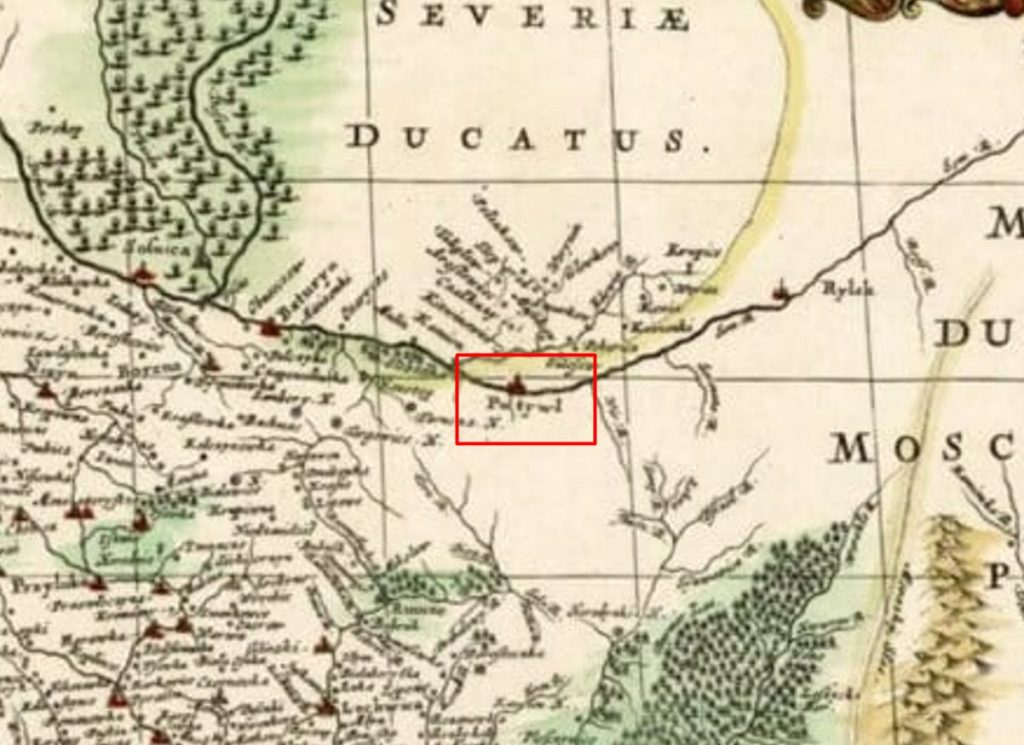“…Having travelled other five miles, over wild deserts and through extensive forests entirely destitute of water, in the course of which progress we had occasional glimpses of the city of Potiblia [Putyvl] from a great distance, we passed the extreme boundary of the Cossack territory, and came to the bank of the river called Sayimi the Deep [Seim River]; which is the first line of frontier of the Muscovite territory… It may be noted, that from this city of Potiblia to Moscow the capital the distance is seven hundred versts, as we were informed: the verst, in the Muscovite language, signifies a Turkish mile, and measures three thousand ells, which is the length also of our miles in Syria. The same distance, viz. from this place to Moscow, is computed at one hundred and forty great Cossack miles… As to the steepness and narrowness of these roads, God Almighty alone knows what they are! From our own country hitherward, we had certainly passed over a long line of road; but anything like the declivity and roughness of these we had never witnessed. To travel on them was a hardship sufficient to turn the hair of young men grey… Along the whole road from Potiblia to Moscow not a single person gave us a cake of bread, either in the towns or villages, because such is not their custom.
It should be remarked, that this town of Potiblia is the road into the country of Moscow, from all parts of ours; and that there is no other way whatsoever but this, which is an immense gulley between high rocks. And what labours and struggles of numbers of men, both Chief Priests and Monks, have been lost on reaching this pass, whence they have been turned back to lament the vanity of their wearisome pilgrimage! As to merchants and traders of all kinds, the Muscovites refuse to know them; and never, for any purpose of traffic, allow them to enter their territory. When the merchants do obtain admission, it is effected by much artifice; and one of their contrivances is, to assemble in a body, and take out a Letter from the Syndicate of one of the Patriarchs, addressed to the Emperor, on business pleasing and agreeable to him, and likely to give him joy. With this, on arriving here at Potiblia, they affect the character of envoys from such and such a Patriarch, commissioned to carry his written message to the Emperor: and having appointed among themselves a chief, they in this capacity effect their entrance into the country, and present their Letters to his Majesty. In the meantime, they secretly transact their mercantile affairs; and then return the way they came, after they have obtained their conge from the Emperor. But this method of proceeding there are but few that know how to manage; those only who have tried it a number of times, and who are acquainted with every span of the road: almost all, such as the Heads of Convents, and ordinary Monks and merchants, wait for the passage of one of the Patriarchs, or some well-known Metropolitan, and by his permission unite themselves to his train.
On his arrival at Potiblia, the prelate calls them his suite, and makes out a list and certificate of their several degrees. The Heads of Convents and the Monks are ranked with his noble attendants; the merchants with his slaves or menials. Being admitted into the interior of the empire, each of them, on occasion, and particularly at the time of asking charity, exhibits his certificate as furnished him by the prelate: and the merchants, under this feigned character, sell and buy what they wish. Afterwards, they all leave the country together. Should any conventual chief or merchant, of whatever respectability or celebrity, come alone,, it is quite impossible that they admit him; and this every person interested well knows. All this is out of hatred to the men of our country and language.” (The Travels of Macarius, Patriarch of Antioch)
Paul of Aleppo (1627 – 1669) was a Syrian archdeacon, traveler, and writer. He accompanied his father, Patriarch Makarios III of Antioch, on a journey from Aleppo to Istanbul, Wallachia, Moldavia, Ukraine, and Muscovy in 1652–9. Paul’s journal of the journey provides valuable eyewitness details about the history, geography, culture, folkways, architecture, and religious life of the indigenous population. In Ukraine, their route started with Rashkiv on the Dnister River (10 June 1654).
Why is this quote important? It plainly shows and can serve as undeniable proof that there was the border between the two countries even 400 years ago. And since the city of Putyvl is currently at the border between ‘Russia’ and Ukraine, Russia’s claims of its ‘historic’ lands in the area of present-day Ukraine are bogus. Read how distinctly different were Ukraine and Muscovy four centuries ago >
As for the terms ‘Muscovy’ and ‘Russia’. Paul of Aleppo uses the term ‘Russia‘ to describe the area of former Kyiv Rus that was, in his opinion, an Empire in the times of Vladimir the Great of Kyiv.
The term ‘Muscovy‘ he used to describe the province controlled by Moscow at the times of his travel which used to be Rostov-Suzdal principality or Moxel in the times of Kyiv Rus realm. Muscovy appropriated the name to which it has no right or legacy – check the link about Moxel.
It is the Beauplan’s map used in this article >
